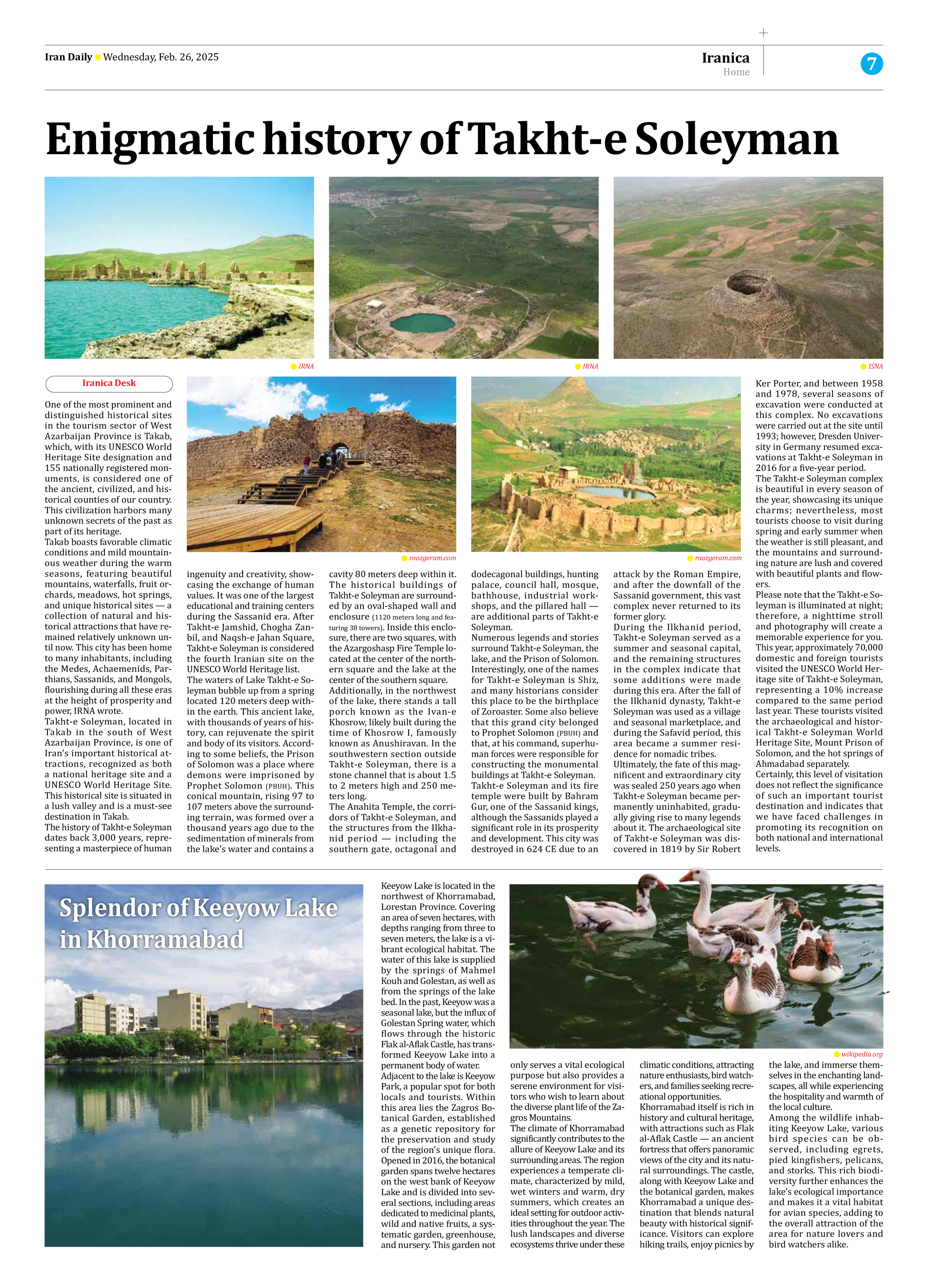
Enigmatic history of Takht-e Soleyman
One of the most prominent and distinguished historical sites in the tourism sector of West Azarbaijan Province is Takab, which, with its UNESCO World Heritage Site designation and 155 nationally registered monuments, is considered one of the ancient, civilized, and historical counties of our country. This civilization harbors many unknown secrets of the past as part of its heritage.
Takab boasts favorable climatic conditions and mild mountainous weather during the warm seasons, featuring beautiful mountains, waterfalls, fruit orchards, meadows, hot springs, and unique historical sites — a collection of natural and historical attractions that have remained relatively unknown until now. This city has been home to many inhabitants, including the Medes, Achaemenids, Parthians, Sassanids, and Mongols, flourishing during all these eras at the height of prosperity and power, IRNA wrote.
Takht-e Soleyman, located in Takab in the south of West Azarbaijan Province, is one of Iran’s important historical attractions, recognized as both a national heritage site and a UNESCO World Heritage Site. This historical site is situated in a lush valley and is a must-see destination in Takab.
The history of Takht-e Soleyman dates back 3,000 years, representing a masterpiece of human ingenuity and creativity, showcasing the exchange of human values. It was one of the largest educational and training centers during the Sassanid era. After Takht-e Jamshid, Chogha Zanbil, and Naqsh-e Jahan Square, Takht-e Soleyman is considered the fourth Iranian site on the UNESCO World Heritage list.
The waters of Lake Takht-e Soleyman bubble up from a spring located 120 meters deep within the earth. This ancient lake, with thousands of years of history, can rejuvenate the spirit and body of its visitors. According to some beliefs, the Prison of Solomon was a place where demons were imprisoned by Prophet Solomon (PBUH). This conical mountain, rising 97 to 107 meters above the surrounding terrain, was formed over a thousand years ago due to the sedimentation of minerals from the lake’s water and contains a cavity 80 meters deep within it.
The historical buildings of Takht-e Soleyman are surrounded by an oval-shaped wall and enclosure (1120 meters long and featuring 38 towers). Inside this enclosure, there are two squares, with the Azargoshasp Fire Temple located at the center of the northern square and the lake at the center of the southern square.
Additionally, in the northwest of the lake, there stands a tall porch known as the Ivan-e Khosrow, likely built during the time of Khosrow I, famously known as Anushiravan. In the southwestern section outside Takht-e Soleyman, there is a stone channel that is about 1.5 to 2 meters high and 250 meters long.
The Anahita Temple, the corridors of Takht-e Soleyman, and the structures from the Ilkhanid period — including the southern gate, octagonal and dodecagonal buildings, hunting palace, council hall, mosque, bathhouse, industrial workshops, and the pillared hall — are additional parts of Takht-e Soleyman.
Numerous legends and stories surround Takht-e Soleyman, the lake, and the Prison of Solomon. Interestingly, one of the names for Takht-e Soleyman is Shiz, and many historians consider this place to be the birthplace of Zoroaster. Some also believe that this grand city belonged to Prophet Solomon (PBUH) and that, at his command, superhuman forces were responsible for constructing the monumental buildings at Takht-e Soleyman.
Takht-e Soleyman and its fire temple were built by Bahram Gur, one of the Sassanid kings, although the Sassanids played a significant role in its prosperity and development. This city was destroyed in 624 CE due to an attack by the Roman Empire, and after the downfall of the Sassanid government, this vast complex never returned to its former glory.
During the Ilkhanid period, Takht-e Soleyman served as a summer and seasonal capital, and the remaining structures in the complex indicate that some additions were made during this era. After the fall of the Ilkhanid dynasty, Takht-e Soleyman was used as a village and seasonal marketplace, and during the Safavid period, this area became a summer residence for nomadic tribes.
Ultimately, the fate of this magnificent and extraordinary city was sealed 250 years ago when Takht-e Soleyman became permanently uninhabited, gradually giving rise to many legends about it. The archaeological site of Takht-e Soleyman was discovered in 1819 by Sir Robert Ker Porter, and between 1958 and 1978, several seasons of excavation were conducted at this complex. No excavations were carried out at the site until 1993; however, Dresden University in Germany resumed excavations at Takht-e Soleyman in 2016 for a five-year period.
The Takht-e Soleyman complex is beautiful in every season of the year, showcasing its unique charms; nevertheless, most tourists choose to visit during spring and early summer when the weather is still pleasant, and the mountains and surrounding nature are lush and covered with beautiful plants and flowers.
Please note that the Takht-e Soleyman is illuminated at night; therefore, a nighttime stroll and photography will create a memorable experience for you. This year, approximately 70,000 domestic and foreign tourists visited the UNESCO World Heritage site of Takht-e Soleyman, representing a 10% increase compared to the same period last year. These tourists visited the archaeological and historical Takht-e Soleyman World Heritage Site, Mount Prison of Solomon, and the hot springs of Ahmadabad separately.
Certainly, this level of visitation does not reflect the significance of such an important tourist destination and indicates that we have faced challenges in promoting its recognition on both national and international levels.







